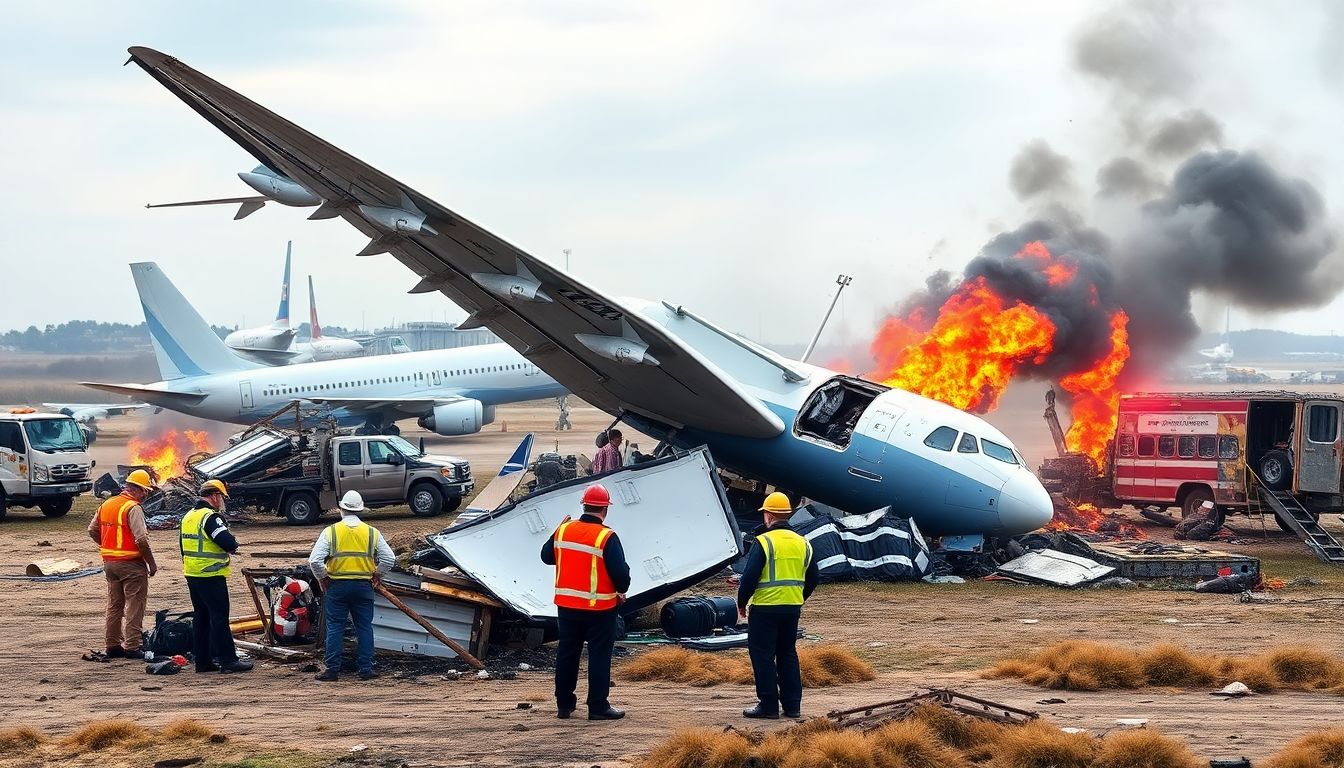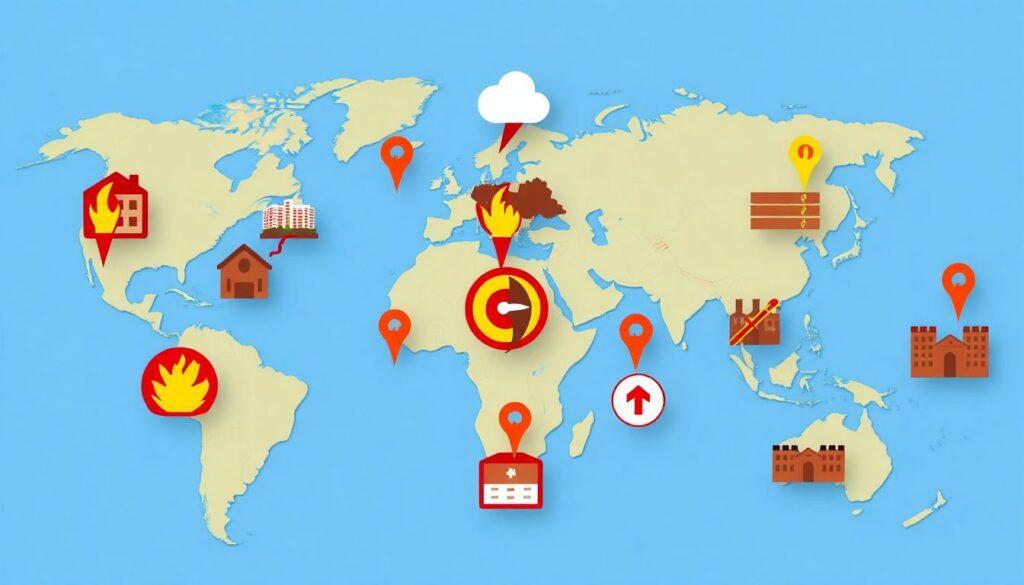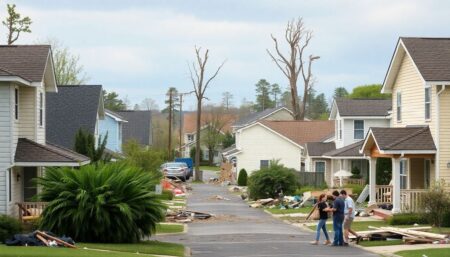Welcome to our comprehensive year-ender for 2024. This year has been a tumultuous journey, marked by natural disasters, human-induced tragedies, and ongoing crises that have left an indelible mark on communities worldwide. Join us as we reflect on these events, understanding their impacts and the lessons they hold for our future.
A look back at the natural disasters, conflicts, and accidents that shaped 2024.
Imagine a global map, not like the ones you’d find in an atlas, but a living, breathing visualization of our planet’s pulse. This isn’t a static image of borders and capitals, but a dynamic snapshot of our world as it lives and breathes, struggles and endures.
Now, picture this map dotted with icons, each a symbol of tragedies that have left indelible marks on our collective consciousness. There’s a cluster of trembling fault lines in the Pacific Ring of Fire, each icon a testament to the earthquakes that have shaken communities to their core. Swirling hurricane symbols scatter across the Atlantic, a stark reminder of the storms that have battered coastlines and upended lives.
Look closer, and you’ll see avalanche icons nestled in mountain ranges, landslide symbols scarring hillsides, and conflict markers clustered in regions torn apart by strife. This map isn’t just about geography; it’s a visual echo of our global history, a poignant depiction of our resilience, and a humbling reminder of the widespread impact that these events have had on our shared human story.

Natural Disasters
The year 2024 was marked by a series of devastating natural disasters that left an indelible impact on communities worldwide. Among the most notable events was the Noto earthquake, which struck Japan with a magnitude of 7.5. The quake resulted in significant infrastructural damage, power outages, and tragically, loss of life. The event highlighted the importance of seismic-resistant construction and the need for robust emergency response protocols.
Meanwhile, in Ethiopia, the Gofa landslides caused immense destruction, burying entire villages under mud and debris. The disaster was exacerbated by heavy rainfall, leading to a high death toll and widespread displacement. Similarly, the Wayanad landslides in India, triggered by incessant monsoon rains, resulted in substantial loss of life and property. Both events underscored the critical need for early warning systems and sustainable land use practices to mitigate such risks.
Hurricane Helene and Cyclone Chido brought forth the fury of nature in the Atlantic and Indian Oceans, respectively. Hurricane Helene, a Category 4 storm, caused extensive flooding and wind damage along the eastern coast of the United States. Cyclone Chido, on the other hand, battered the coasts of Madagascar and Mozambique, leading to widespread power outages and infrastructural damage. These events emphasized the importance of preparedness, including the construction of storm-resistant buildings and the establishment of effective evacuation plans.
Lastly, Typhoon Yagi wreaked havoc in the Philippines, bringing torrential rains and powerful winds that resulted in severe flooding and landslides. The typhoon’s impact was felt across numerous islands, disrupting communication and transportation networks. The disaster served as a stark reminder of the need for comprehensive disaster management strategies, including community education and the development of resilient infrastructure. Lessons learned from these events include:
- The importance of early warning systems and community education.
- The need for robust emergency response protocols.
- The critical role of sustainable land use practices and resilient infrastructure.

Human-Induced Tragedies
The year 2024 has been marred by a series of human-induced tragedies that have left indelible marks on societies worldwide. In January, a shooting at a concert hall in Moscow left dozens dead and hundreds injured. The reverberations of this senseless act of violence were felt not only in Russia but around the globe. The once-thriving music scene in Moscow has been silenced, replaced by a palpable sense of fear and uncertainty. The societal impact of this tragedy has been profound, with increased demands for stricter gun control laws and better mental health support systems. The collective grief and anger have sparked conversations about the need for unity and peace in a world that seems increasingly divided.
Meanwhile, political turmoil in Bangladesh has reached a boiling point. The year began with widespread protests against government policies, which have since escalated into violent clashes between law enforcement and civilians. The unrest has led to a significant loss of life and property, further destabilizing the region. The societal impacts of this turmoil are far-reaching:
- Economic instability, with businesses shutting down and investors pulling out.
- A humanitarian crisis, with thousands displaced from their homes.
- A surge in extremist ideologies, as desperate individuals turn to radical groups for support.
The need for peaceful dialogue and political stability has never been more urgent.
The tragedies of 2024 serve as a stark reminder of the fragility of human life and the destructive power of conflict. Whether it’s the brutal shooting in Moscow or the political chaos in Bangladesh, the ripple effects of these events extend far beyond their immediate surroundings. They highlight the interconnectedness of our world and the importance of fostering understanding, empathy, and cooperation among nations.
As we navigate through these tumultuous times, it is crucial that we advocate for peace and stability. This means investing in education to promote critical thinking and tolerance, strengthening institutions to ensure accountability and justice, and encouraging open dialogue to bridge divides and foster mutual respect. Only by working together can we hope to heal the wounds of 2024 and build a more peaceful and prosperous future for all.

Severe Weather Events
The year 2024 has been marked by a series of severe weather events that have left devastating impacts worldwide. In June, Las Vegas experienced a record-breaking heat wave with temperatures soaring above 120°F (49°C) for several consecutive days. The intense heat led to widespread power outages, as the electrical grid struggled to meet the demand for air conditioning. Residents and tourists alike were forced to endure the scorching heat, resulting in numerous cases of heat exhaustion and heatstroke. Meanwhile, across the globe, the annual Hajj pilgrimage in Saudi Arabia turned deadly as millions of worshippers faced extreme heat waves, leading to a significant number of deaths from heat-related illnesses.
Simultaneously, Spain was battered by unprecedented flash floods that swept through major cities and rural areas alike. Torrential downpours caused rivers to burst their banks, inundating homes, businesses, and critical infrastructure. The deluge left thousands displaced and resulted in substantial economic losses. Key agricultural regions were particularly hard hit, with crops destroyed and farmland washed away, raising concerns about long-term food security.
These events serve as stark reminders of the growing impact of climate change. Rising global temperatures are fueling more frequent and intense heat waves, while altered precipitation patterns are leading to both severe droughts and catastrophic floods. Scientists warn that without significant reductions in greenhouse gas emissions, such extreme weather events will become the new normal. To mitigate these risks, governments and communities must prioritize climate action and invest in resilient infrastructure.
Beyond addressing the root causes of climate change, there is an urgent need to improve emergency response systems. The severe weather events of 2024 highlighted critical gaps in preparedness and response. To better protect lives and property, governments should invest in:
- Early warning systems that provide timely and accurate information to the public.
- Robust emergency services equipped to handle large-scale disasters.
- Community education programs that empower individuals to take proactive measures during extreme weather events.
- Infrastructure upgrades that enhance the resilience of power grids, water systems, and transportation networks.
By taking these steps, we can work towards minimizing the human and economic toll of future severe weather events.

Aviation Disasters
The year 2024 was marked by several tragic aviation disasters that served as stark reminders of the importance of aviation safety. The first notable incident was the Haneda Airport runway collision in Tokyo, Japan. On a foggy morning, a departure from standard communication protocols led to a catastrophic runway incursion, resulting in the collision of two aircraft. This event underscored the critical need for strict adherence to communication procedures and the role of clear visibility in preventing such disasters.
Next, the crash of Flight 2283 in Brazil sent shockwaves through the aviation community. Investigations revealed that a combination of severe weather conditions and pilot error contributed to the tragedy. The aircraft, en route from São Paulo to Rio de Janeiro, encountered a sudden thunderstorm that overwhelmed the crew’s ability to navigate safely. This incident highlighted the necessity for advanced weather detection systems and rigorous pilot training to handle extreme conditions.
The Azerbaijan plane crash was another harrowing event that brought aviation safety to the forefront. A technical malfunction in the aircraft’s engine caused a catastrophic failure mid-flight, leading to a devastating crash. The subsequent investigation uncovered lapses in maintenance protocols, emphasizing the crucial role of regular and thorough aircraft inspections in ensuring passenger safety. This disaster served as a grim reminder that even the smallest oversight in maintenance can have dire consequences.
Lastly, the South Korea plane crash was a poignant example of how human factors can contribute to aviation disasters. The crash was attributed to a series of poor decisions made by the flight crew under stressful conditions. Key findings from the investigation included:
- Inadequate crew resource management (CRM),
- Fatigue and stress affecting the crew’s decision-making abilities,
- Lack of effective communication among the crew members.
This tragedy underscored the importance of robust training programs that focus on CRM, stress management, and effective communication strategies. In summary, the aviation disasters of 2024 were a sobering reminder of the multifaceted nature of aviation safety, encompassing technical, environmental, and human factors. Each incident provided valuable lessons that the aviation industry must heed to prevent future tragedies and ensure the safety of all passengers and crew.
FAQ
What were the most devastating natural disasters of 2024?
How did human-induced tragedies impact societies in 2024?
What were the severe weather events of 2024 and their impacts?
What aviation disasters occurred in 2024?
What ongoing crises continued into 2024?
- Drought in Zambia
- Russia-Ukraine war
- Israel-Hamas war
- Sudanese civil war
These crises highlighted the urgent need for humanitarian aid and resolution to prevent further suffering.









